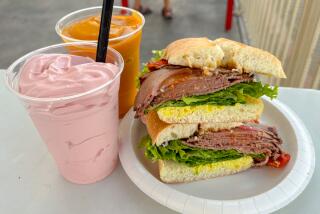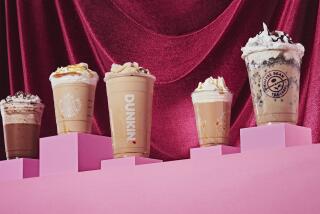Competition Sharpens for New Market : Low-Cal Frozen-Fruit Bars Appeal to Tastes of Diet-Conscious Americans
- Share via
Chunks of whole fruit and fruit juice frozen on a stick may be the hottest snack food you can buy this summer.
They are called frozen fruit bars. The major contenders in the growing market, Frozfruit Gourmet Frozen Fruit Bars and Shamitoff’s Natural Fruit Bars, have revolutionized the frozen-dessert industry in the past four or five years.
These frozen-fruit desserts boast authentic fruit flavors, all natural ingredients and a double-barreled bonus: They are actually nutritious, as well as being low in calories.
Predictably, America’s diet-conscious consumers have caused sales of these frozen treats to soar.
Fifteen million Frozfruit were sold in 1984, according to Don Meagher, the company’s sales manager.
Shamitoff president Bob Harris said sales from March 1984 to March 1985 have tripled over the same period the year before. “We are doing extremely well,” he said, “and we expect to do $3 million in the New York market this year.”
Temperature Up, Prices Down
His expectation is probably based on the increased sales expected during the price war he says could erupt this summer, when Shamitoff lowers its price 20 cents to $1.59 for a package of four, almost a dollar lower than Frozfruit’s.
Sales activity is all the more notable in light of the fact that neither company has yet advertised; both have relied on word of mouth to hype their products. (Shamitoff’s officials reveal, however, that they are planning a huge TV campaign in 1986, bankrolled by this year’s profits.)
Success of these products fits into a growing market for fruit juices. “There has been a great demand in this country in the past years for natural fruit juices,” said Martin Friedman, editor of New Product News, “and parents are giving them to their children as a replacement for soft drinks.”
Friedman, who tracks trends in supermarket items, said: “These fruit bars are an obvious replacement for juice and fruit. They replace snacks like cookies, candy or ice cream. Most people think the fruit sugar is better for you, but there probably isn’t any difference.”
Potential profits have attracted a number of food companies into this market and caused frozen-fruit selections to proliferate in supermarket freezers.
Getting Into the Action
Dole has put a lot of money into advertising its Fruit ‘n Juice bars, a combination of pureed fruit and juice frozen on a stick. Frozen grape and orange juice are packaged by Guido in a plastic squeeze tube. General Foods followed up its Pudding Pops with Jell-O-Gelatin Pops, 35 calories of whipped gelatin in familiar Jell-O fruit flavors.
Still being test-marketed in selected areas are Rainbow frozen fruit bars made by Borden’s, Ice Juicee made by Gold Shield Foods and something called the Teddy Bar put out by a company in Texas. The latest Popsicle from Consolidated Foods is a concoction called Chocolate-Peanut Butter Good ‘n Pudding Pop.
Unlike these competitors, Frozfruit and Shamitoff are mostly fruit, crushed or chunked, in a water or milk base. In fact, real pieces of fruit show up in the pops: chunks of strawberries, sweet and sour cherries, shreds of coconut. Watermelon pops will occasionally even produce a seed or two.
Both brands contain no artificial colorings, fillers or preservatives. Natural stabilizers such as cellulose gum, guar gum and carrageenin prevent ice crystals from forming as the fruit is being frozen.
Stick-to-the-Stick-ness
The bars can be stored in the freezer for several months, and because of the abundance of fruit fiber are not likely to drip while being eaten or to fall off the stick, a definite advantage over ice pops. The fruit bars are low in calories, sugar, salt and fat.
The frozen-fruit pop is relatively new on the scene. Three years ago, Frozfruit was sold minimally in California.
Instead of the traditional advertising approach to sell a new product, Frozfruit officials gave away free samples. “Once people tasted them, they would buy them,” said sales manager Meagher. “We gave away 20,000 Frozfruit bars at the New York Marathon last year.”
At first (if you couldn’t get one for free), single Frozfruit bars were available exclusively in convenience stores, institutional cafeterias and school lunchrooms.
Now, four flavors (strawberry, coconut, banana and pineapple) are packaged in four-bar packages and sold in supermarkets, delis and groceries for about $2.49 a box.
Customers will find all 14 flavors of Frozfruit made in one size, 4 ounces, and single bars sell from 79 to 89 cents a piece or as high as $1. The water-based flavors (strawberry, boysenberry, watermelon, cantaloupe, raspberry, cherry, orange, lemon, lime, pineapple, mango, peach) contain 17 calories per ounce, the milk-based flavors (strawberry, boysenberry, coconut, banana) 30 calories per ounce.
Frozfruit’s biggest competitor is Shamitoff’s Natural Fruit Bars, based in Redwood City, Calif.
In the late 1970s, Joel Shamitoff, a San Diego deli owner, began freezing chunks of fruit in molds in the back room of his store.
Sold in Eight Foreign Countries
He sold his rights and name in 1980 to Paul Resnick, and now the fruit bars are made in eight flavors in Green Bay, Wis., and can be purchased in four-packs and single bars in 45 states and eight foreign countries.
The Shamitoff fruit bars are manufactured in two sizes. The 2 1/2-ounce bars are packed in boxes of four in banana and cream (90 calories each), dark sweet cherry (47 calories each), chocolate-covered coconut cream (195 calories each), pineapple (50 calories each), strawberry (43 calories), peaches and cream (65 calories) and pina colada (79 calories).
The 3-ounce bars come in dark sweet cherry (57 calories), strawberry (52 calories) and coconut cream (135 calories). These are sold singly in convenience stores and food-service counters for 59 cents apiece.
Should you be inspired to try your own hand at making frozen-fruit pops, here is a strawberry version to try at home. It relies on gelatin as its stabilizer.
STRAWBERRY FRUIT POPS
1/2 teaspoon unflavored gelatin
1/4 cup cold water
1 cup chopped ripe strawberries
2 to 4 tablespoons sugar
1 teaspoon lemon juice
1/3 cup light corn syrup
In small heat-proof custard cup, sprinkle gelatin over cold water. Stir and set aside 10 minutes. Place dish in small pan of water and heat gently until gelatin is completely dissolved. Cool.
Place strawberries in medium bowl and sprinkle with sugar. Stir gently and set aside 15 minutes. Combine cooled gelatin mixture, strawberries with their juice, lemon juice and corn syrup. Spoon into ice pop molds and freeze at least 2 hours. Makes about 10 fruit pops.
More to Read
Eat your way across L.A.
Get our weekly Tasting Notes newsletter for reviews, news and more.
You may occasionally receive promotional content from the Los Angeles Times.










